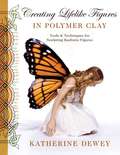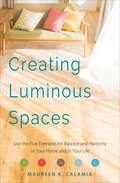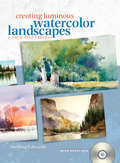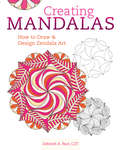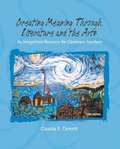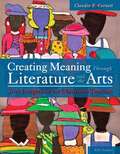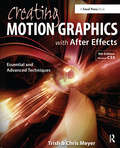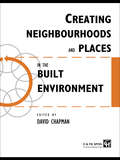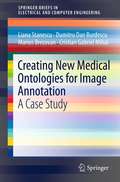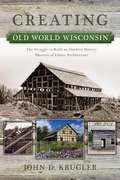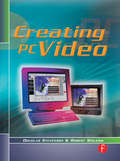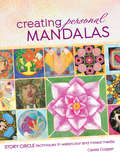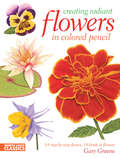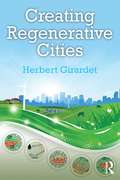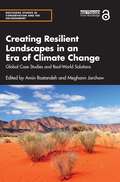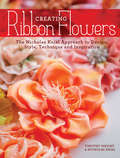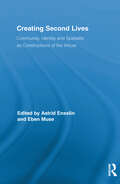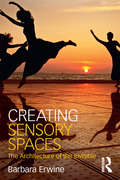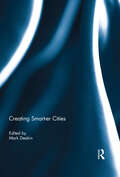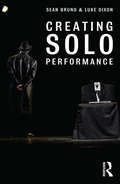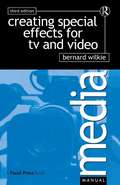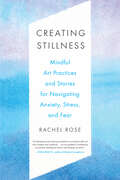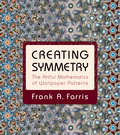- Table View
- List View
Creating Lifelike Figures in Polymer Clay: Tools and Techniques for Sculpting Realistic Figures
by Katherine DeweyKatherine Dewey's expressive and elegantly detailed sculptures enchant all who see them. With the magical medium of polymer clay and this book, you can follow in her footsteps.Thorough instructions supported by more than 400 step-by-step color photos and 200 detailed drawings cover the entire process of sculpting realistic figures, from selecting clay and gathering essential tools to the basics of modeling the human figure, to incorporating poses, facial expressions, ethnic and gender subtleties, costumes, and painted finishing touches. Easy-to-read maps of the figure illustrate the landmarks of the body, while scale diagrams indicate the simple shapes hidden within the human form, as well as how to combine and model those shapes.For anyone who loves fantasy, romance, nature--or sophisticated crafting--this book is a must-have.
Creating Luminous Spaces: Use the Five Elements for Balance and Harmony in Your Home and in Your Life
by Maureen K. CalamiaAncient and global modern design come together in this practical guide to interior design, biophilic design, and feng shui for your home. Part spiritual growth workbook and part treatise on the power of nature, Creating Luminous Spaces is your practical guide to giving your home a refreshing energy boost. In this inventive approach to interior design, Maureen K. Calamia blends modern trends with the five elements of feng shui, an ancient Chinese system that brings the cycles and benefits of nature to your home interior. With inspiring ideas and practical information, Calamia will help you discover which of nature&’s elements represents your energy. Should you enhance your home with natural light or a fish bowl? New organizational habits or tall, vertical lines? Featuring practical exercises, meditations, and real stories about clients and students, as you embark on this mind-body-spirit connection with your home, you&’ll find out how: Indoor lighting and lighting design can strengthen the fire elementOrganizational behavior is influenced by the metal elementSpace planning with plants nourishes the wood elementAnd more!
Creating Luminous Watercolor Landscapes
by Sterling EdwardsHow to paint your world in watercolor...and have fun doing it! The day Sterling Edwards watched an artist paint an entire sky with three deft brushstrokes was the day he committed to trading his tiny oil brushes and photorealistic style in favor of big, bold strokes of watercolor. In the years since, he's developed not only a wonderfully fresh, luminous painting style, but also an approach that takes the intimidation out of this beautiful but often-mystifying medium. In this book, he shares both. Initial chapters lay the foundation for successful paintings, from choosing the right brushes to achieving vibrant colors, interesting textures and strong compositions. Step-by-step demonstrations illustrate techniques for painting rocks, skies, trees, foliage, buildings, water and other landscape elements. An easy-to-follow, four-step painting process makes for easier starts and stronger finishes, complete with rich darks and sparkling highlights. Eight complete painting projects cover a range of breathtaking scenes and seasons. Whether you're dipping into the medium for the first time or you're a watercolor devotee on a quest for clearer color and more personal statements, this book will help you make the most of the time you spend with brush in hand.
Creating Mandalas: How to Draw and Design Zendala Art
by Deborah PacéMASTER THE ART OF MAKING MANDALAS!The art of making mandalas and zendalas is less about drawing and more about slowing down and opening up to your inner creative flow. You do not have to be an artist. There is no need to know how to draw. All you need are some simple everyday tools and a little effort. Can you create a circle using a compass and pencil? Can you draw a line? Can you repeat patterns? Then YOU can create your own mandalas and zendalas!Get inspired with more than 40 project ideas, step-by-step demonstrations, templates and gallery pieces.Whether you prefer to plan or would rather go with the flow, practice pages throughout the book make it easy to get started.Find tips for adding Zentangle patterns, coloring, drawing on colored paper, with stencils, and creating gold-leafed, Spirograph-inspired and snowflake mandalas.Discover your style, whether it be structured, freeform, bold and dramatic, or whimsical, and learn to design, draw and color your own original works of mandala and zendala art. Simply breathe, reach for your pencil and begin.
Creating Meaning Through Literature and the Arts: An Integration Resource for Classroom Teachers (Third Edition)
by Claudia E. CornettThe most comprehensive text on arts integration in the market, this bestseller redefines literacy in light of the 21st century need for multiple literacies. It provides an overview of academically linked research in five arts areas: literary arts, visual art, drama, dance, and music, and is intended as a complete introduction to how to meaningfully use the arts as teaching tools on a daily basis in every curricular area. Organized around WHAT, WHY and HOW questions, Creating Meaning through Literature and the Arts, 5/e tells the story of how arts integration (AI) has grown so much in a few decades using the story of hundreds of arts-based schools–old and new, public, magnet, and charter, today’s. Each AI school story draws upon cutting edge research, evolving state standards, and constructivist beliefs to transform teaching and learning. The Enhanced Pearson eText features video resources.
Creating Meaning Through Literature and the Arts: Arts Integration for Classroom Teachers
by Claudia E. CornettThe most comprehensive text on arts integration in the market, this bestseller redefines literacy in light of the 21st century need for multiple literacies. It provides an overview of academically linked research in five arts areas: literary arts, visual art, drama, dance, and music, and is intended as a complete introduction to how to meaningfully use the arts as teaching tools on a daily basis in every curricular area. Organized around WHAT, WHY and HOW questions, Creating Meaning through Literature and the Arts, 5/e tells the story of how arts integration (AI) has grown so much in a few decades using the story of hundreds of arts-based schools–old and new, public, magnet, and charter, today’s. Each AI school story draws upon cutting edge research, evolving state standards, and constructivist beliefs to transform teaching and learning.
Creating Motion Graphics with After Effects: Essential and Advanced Techniques (Dves/dv Expert Ser.)
by Chris Meyer Trish MeyerTrish and Chris Meyer share over 17 years of hard-earned, real-world film and video production experience inside this critically acclaimed text. More than a step-by-step review of the features in AE, readers will learn how the program thinks so that they can realize their own visions more quickly and efficiently. This full-color book is packed with tips, gotchas, and sage advice that will help users thrive no matter what projects they might encounter. Creating Motion Graphics 5th Edition has been thoroughly revised to reflect the new features introduced in both After Effects CS4 and CS5. New chapters cover the revolutionary new Roto Brush feature, as well as mocha and mocha shape. The 3D section has been expanded to include working with 3D effects such as Digieffects FreeForm plus workflows including Adobe Repoussé, Vanishing Point Exchange, and 3D model import using Adobe Photoshop Extended. The print version is also accompanied by a DVD that contains project files and source materials for all the techniques demonstrated in the book, as well as nearly 200 pages of bonus chapters on subjects such as expressions, scripting, and effects. Subjects include: Animation Techniques; Layer Management; Modes, Masks, and Mattes; Mastering 3D Space; Text Animation; Effects & Presets; Painting and Rotoscoping; Parenting, Nesting, and Collapsing; Color Management and Video Essentials; Motion Tracking and Keying; Working with Audio; Integrating with 3D Applications; Puppet Tools; Expressions; Exporting and Rendering; and much more.
Creating Neighbourhoods and Places in the Built Environment (Built Environment Series Of Textbooks Ser.)
by David ChapmanThis design primer examines the forces at work in the built environment and their impact on the form of buildings and their environments. The actions of a range of individuals and agencies and the interaction between them is examined, exploring the competing interests which exist, their interaction with physical and environmental forces and the uncertain results of both individual and corporate intervention.
Creating New Medical Ontologies for Image Annotation: A Case Study (SpringerBriefs in Electrical and Computer Engineering)
by Liana Stanescu Dumitru Dan Burdescu Marius Brezovan Cristian Gabriel MihaiCreating New Medical Ontologies for Image Annotation focuses on the problem of the medical images automatic annotation process, which is solved in an original manner by the authors. All the steps of this process are described in detail with algorithms, experiments and results. The original algorithms proposed by authors are compared with other efficient similar algorithms. In addition, the authors treat the problem of creating ontologies in an automatic way, starting from Medical Subject Headings (MESH). They have presented some efficient and relevant annotation models and also the basics of the annotation model used by the proposed system: Cross Media Relevance Models. Based on a text query the system will retrieve the images that contain objects described by the keywords.
Creating Old World Wisconsin
by John D. KruglerWith its charming heirloom gardens, historic livestock breeds, and faithfully recreated farmsteads and villages that span nearly 600 acres, Old World Wisconsin is the largest outdoor museum of rural life in the United States. But this seemingly time-frozen landscape of rustic outbuildings and rolling wooded hills did not effortlessly spring into existence, as John D. Krugler shows in Creating Old World Wisconsin. As dozens of historic buildings were transported in the 1970s from various locations throughout the state to the Kettle Moraine State Forest, researchers, curators, and volunteers launched a massive preservation initiative to salvage fast-disappearing immigrant and migrant architecture. They created a backdrop against which twenty-first-century interpreters demonstrate nineteenth- and early twentieth-century agricultural techniques and artisanal craftsmanship. The site, created and maintained by the Wisconsin Historical Society, offers visitors a unique opportunity to learn about the states rich and ethnically diverse past through depictions of the everyday lives of its Norwegian, Danish, Finnish, German, Polish, African American, and Yankee inhabitants. Creating Old World Wisconsin chronicles the fascinating and complex origins of this outdoor museum, highlighting the struggles that faced its creators as they worked to achieve their vision. Even as Milwaukee architect and preservationist Richard W. E. Perrin, the Societys staff, and enthusiastic volunteers opened the museum in time for the national bicentennial in 1976, the site was plagued by limited funds, bureaucratic tangles, and problems associated with gaining public support. By documenting the engaging story of the challenges, roadblocks, false starts, and achievements of the sites founders, Krugler brings to life the history of the dedicated corps who collected and preserved Wisconsins diverse social history and heritage.
Creating PC Video
by Douglas Stevenson Robert WolenikThis book teaches readers how to put a working system together by showing them the equipment available to them, and what it can do. Readers will learn how to create video products using the computer as an editing tool, and how to refine sound and combine graphics with video. Information on web distribution is included. With the advent of the new digital camcorders developed by Panasonic and Sony in the new DV format, professional quality video is available in consumer-level equipment. At the same time, digital editing is now available for the PC using video capture cards in the $500-$1,000 price range, and digital editing software in the $800-$1,200 range, such as Adobe Premiere. This combination enables users such as the sophisticated amateur video maker, the wedding or business presentation video maker, and people working in multimedia for educational, training, or other presentation purposes, to edit their own work and turn out competent professional-quality video.
Creating Personal Mandalas: Story Circle Techniques in Watercolor and Mixed Media
by Cassia CoggerRelax your spirit and reconnect to your authentic voice. Discover the simple magic and mystery that awaits you when you express yourself within the safe space of a circle. In Creating Personal Mandalas, you'll see how this most basic of shapes can open your heart and always leads you back to your center. In each of the 10 chapters, you'll explore two soul-expressing mandala exercises, facts and history on featured symbols, insights for using the confines of the circle for personal and visual storytelling, as well as inspiring art and reflections from contributing guest artists.20 exploratory step-by-step mandala exercises--each an opportunity for new self-exploration, beginning with tips on establishing the right mindsetInteresting facts about symbols and sacred geometry, including suggestions for using them in your mandala projectsPractical art-making direction on the elements of design, watercolor tips, composition prompts, seeing color as a storytelling element and moreUse Creating Personal Mandalas to start expressing your life stories with the infinite possibilities of the circle.
Creating Radiant Flowers in Colored Pencil: 64 step-by-step demos / 54 kinds of flowers
by Gary GreeneMaster the Secret of Creating Spectacular Flowers in Colored Pencil When it comes to choosing a subject, flowers are a perennial favorite for artists because of their exciting variety and complexity of color, texture and details. It's amazing, then, that their vibrant natures can be captured so realistically with the simple and direct medium of colored pencil. The "secret" is making the most of colored pencil's distinctive translucent properties with techniques such as layering, burnishing and underpainting. Gary Greene--along with six other respected colored pencil artists--shows you how in 64 step-by-step demonstrations. Arranged from azalea to zinnia for easy reference, these demonstrations detail the methods and specific colors for creating a variety of flowers, including: anthurium * amaryllis * aster * begonia * bird of paradise * cactus flower * calla lily * camellia * carnation * chrysanthemum * cineraria * crocus * columbine * daffodil * dahlia * Easter cactus * foxglove * fuchsia * geranium * Gerbera daisy * gladiolus * hibiscus * hydrangea * hyacinth * iris * lily * lupine * magnolia * marigold * nasturtium * passion flower * peony * petunia * poinsettia * poppy * primrose * rhododendron * slipperwort * snapdragon * sunflower * trillium * tulip * water lily Complete with advice on the best tools and reference materials, this unique guide helps you capture the beauty of flowers in colored pencil.
Creating Regenerative Cities
by Herbert GirardetLarge, modern cities have effectively declared their independence from nature. But while they take up only three percent of the world’s land surface, their ecological footprints actually cover the entire globe. Humanity is building an urban future, yet urban resource use is threatening the future of humanity and the natural world. To meet the aspirations of city people in both developing and developed countries, bold new initiatives are needed. Modern cities are an astonishing human achievement. As centres of innovation they are humanity’s cultural playgrounds. Their communication and transport systems have developed a global reach. They are attractive to investors because they can offer a vast variety of services at comparatively low per-capita costs. But are they viable as ecological systems? The planning of new cities, as well as the retrofit of existing cities, needs to undergo a profound paradigm shift. Mere 'sustainable development' is not enough. To be compatible with natural systems, cities need to move away from linear systems of resource use and learn to operate as closed-loop, circular systems. To ensure their long-term future, they need to develop an environmentally enhancing, restorative relationship between themselves and the natural systems on which they still depend. Creating Regenerative Cities is a concise, solution-oriented manual for creating regenerative urbanisation. A wide range of technical, management and policy solutions already exist, but implementation has been too slow and too little, in large part because the kinds of holistic approaches needed are still unfamiliar to fragmented and process-driven urban policy making and governance. Herbert Girardet's 30 years’ experience as an ecologist, thinker, film maker and consultant working around the world has created this unique combination of tried and tested best practices and policies, which outlines the fundamental shifts needed in the way we think about our cities.
Creating Resilient Landscapes in an Era of Climate Change: Global Case Studies and Real-World Solutions (Routledge Studies in Conservation and the Environment)
by Amin Rastandeh Meghann JarchowThis book delivers a realistic and feasible framework for creating resilient landscapes in an era of anthropogenic climate change. From across six continents, this book presents fifteen case studies of differing sociocultural, economic, and biophysical backgrounds that showcase opportunities and limitations for creating resilient landscapes throughout the world. The potential to create socio-ecological resilience is examined across a wide range of landscapes, including agricultural, island, forest, coastal, and urban landscapes, across sixteen countries: Argentina, Australia, Brazil, Denmark, Finland, Greece, Guatemala, Japan, Mexico, Norway, Samoa, South Africa, the United States, Turkey, Uruguay, and Vanuatu. Chapters discuss current and future issues around creating a sustainable food system, conserving biodiversity, and climate change adaptation and resilience, with green infrastructure, nature-based architecture, green-tech, and ecosystem services as just a few of the approaches discussed. The book emphasizes solution-oriented approaches for an "ecological hope" that can support landscape resiliency in this chaotic era, and the chapters consider the importance of envisioning an unpredictable future with numerous uncertainties. In this context, the key focus is on how we all can tackle the intertwined impacts of climate change, biodiversity loss, and large-scale land-cover conversion in urban and non-urban landscapes, with particular attention to the concept of landscape resiliency. The volume provides that much-needed link between theory and practice to deliver forward-thinking, practical solutions. This book will be of great interest to students, researchers, practitioners and policymakers who are interested in the complex relationship between landscapes, climate change, biodiversity loss, and land-based conversion at local, national and global scales.
Creating Ribbon Flowers: The Nicholas Kniel Approach to Design, Style, Technique & Inspiration
by Nicholas Kniel Timothy WrightMaster the art of ribbon flowers! Nicholas Kniel and Timothy Wright teach their method of creating gorgeous ribbon flowers in this collection of illustrated, step-by-step lessons. With only a few yards of ribbon, you can make the perfect embellishment for any garment, home decor item, wedding party and more. 33 flowers provide a wide range of options for any craft or sewing project. 9 project ideas inspire you to create popular ribbon flower items, such as corsages, boutonnieres, French bulletin boards, bouquets and hair pins, or to design your very own creations. 10 techniques describe how to prepare ribbons for use and how to finish the final flower with clips, pins and stems.
Creating Second Lives: Community, Identity and Spatiality as Constructions of the Virtual (Routledge Studies in New Media and Cyberculture)
by Astrid Ensslin Eben MuseThis book aims to provide insights into how ‘second lives’ in the sense of virtual identities and communities are constructed textually, semiotically and discursively, specifically in the online environment Second Life and Massively Multiplayer Online Games such as World of Warcraft. The book’s philosophy is multi-disciplinary and its goal is to explore the question of how we as gamers and residents of virtual worlds construct alternative online realities in a variety of ways. Of particular significance to this endeavour are conceptions of the body in cyberspace and of spatiality, which manifests itself in ‘natural’ and built environments as well as the triad of space, place and landscape. The contributors’ disciplinary backgrounds include media, communication, cultural and literary studies, and they examine issues of reception and production, identity, community, gender, spatiality, natural and built environments using a plethora of methodological approaches ranging from theoretical and philosophical contemplation through social semiotics to corpus-based discourse analysis.
Creating Sensory Spaces: The Architecture of the Invisible
by Barbara ErwineCreating Sensory Spaces celebrates spaces enlivened with sensual richness and provides you with the knowledge and tools necessary to create them. Drawing on numerous built case studies in ten countries and illustrated with over 85 full color images, the book presents a new framework for the design of sensory spaces including light, color, temperature, smell, sound, and touch. Bridging across disciplines of architecture, engineering, phenomenology and perceptual psychology, this book informs the design of buildings and neighborhoods that reclaim the role of the body and all the senses in creating memorable experiences of place and belonging.
Creating Smart-er Cities
by Mark DeakinDrawing upon the smart experiences of "world class" cities in North America, Canada and Europe, this book provides the evidence to show how entrepreneurship-based and market-dependent representations of knowledge production are now being replaced with a community of policy makers, academic leaders, corporate strategists and growth management alliances, with the potential to liberate cities from the stagnation which they have previously been locked into by offering communities: the freedom to develop polices, with the leadership and strategies capable of reaching beyond the idea of "creative slack"; a process of reinvention, whereby cities become "smarter," in using intellectual capital to not only meet the efficiency requirements of wealth creation, but to become centres of creative slack; the political leadership capable of not only being economically innovative, or culturally creative, but enterprising in opening-up, reflexively absorbing and discursively shaping the democratic governance of such developments; the democratic governance to sustain such developments. Drawing together the critical insights from papers from a collection of leading international experts on the transition to smart cities, this book proposes to do what has recently been asked of those responsible for creating Smarter Cities. That is: provide the definitional components, critical insights and institutional means by which to get beyond the all too often self-congratulatory tone cities across the world strike when claiming to be smart and by focussing on the critical role master-plans and design codes play in supporting the sustainable development of communities.This book was published as a special issue of Urban Technology.
Creating Solo Performance
by Luke Dixon Sean BrunoCreating Solo Performance is an innovative toolbox of exercises and challenges focused on providing you – the performer – with engaging and inspiring ways to explore and develop your idea both on the page and in the performance space. The creation of a solo show may be the most rewarding, liberating and stressful challenge you will take on in your career. This book acts as your silent collaborator as you develop your performance, by helpfully arranging exercises under the following headings: Beginnings Creating character Generating material Using your performance space Technology Endings Collaboration Exercises can be explored in sequence, at random or according to your specific needs and interests as a performer. By enabling you to create a bespoke formula that best applies to your specific subject, area of interest, style and discipline, this book will become an indispensable resource as you produce your solo show.
Creating Special Effects for TV and Video (Media Manuals Ser.)
by Bernard WilkieCreating Special Effects for TV and Video is a concise and practical introduction to the techniques used in television production. Now completely updated, this third edition covers a wide range of special effects in a simple and practical form, with clear illustrations and photographs that support the text. Creating Special Effects for TV and Video is a concise and practical introduction to the techniques used in television production. Now completely updated, this third edition covers a wide range of special effects in a simple and practical form, with clear illustrations and photographs that support the text.Bernard Wilkie now a freelance consultant, director and writer, spent 25 years creating special effects for BBC TV where he became manager of one of the largest and most specialised visual FX units in the world.
Creating Stillness: Mindful Art Practices and Stories for Navigating Anxiety, Stress, and Fear
by Rachel RoseDiscover the healing power of expressive arts with this hands-on guide to using creative mindfulness to reduce stress, find presence, and unlock self-knowledge Expressive arts educator Rachel Rose weaves together mindfulness practice and art therapy to demonstrate how tapping into your own innate creativity can help you find peace in a stressful worldThis self-directed guide teaches ten key principles of mindfulness through ten creative invitations, along with a series of simple exercises and guided prompts to help you start noticing and flexing your creative mindfulness muscles: Anchoring your practice with ritual Setting intentions Honoring your impulses Trusting the process Non-striving Letting goRequiring no prior experience of the arts or mindfulness meditation, Creating Stillness provides tools to explore difficult emotions and find insight into personal struggles and traumatic wounds.In each chapter, Rose draws from her personal experience as a teacher and facilitator of creative mindfulness to share stories and examples that help ground exercises like sketching, creative writing prompts, and more.Rose carefully walks through the process each time, explaining how to set intention and arrive in the present moment before embarking on your mindful art session; how to use objects and thoughts as creative prompts; how to return your attention to your work as you move forward; and how to distill the wisdom you have found in the process. For seasoned artists, creative mindfulness offers a chance to slow down and rediscover the transformative power that art can offer when it is detached from the need to produce something beautiful or useful. For those coming to expressive arts with existing mindfulness practices or engaged in a therapeutic process, a mindful arts practice may reveal a passion for creation you didn&’t know existed. And for everyone, creative mindfulness can help us make sense of our feelings and find new ways of expressing ourselves--in art and in life.
Creating Successful Communities: A Guidebook To Growth Management Strategies
by Luther Propst Michael The Conservation Foundation Stephen F. Harper Michael MantellCreating Successful Communities is a practical compendium of techniques for effective land use and growth management. It offers a framework for land-use decisionmaking and growth management: techniques for protecting key resources such as agricultural land, open space, historic and cultural structure, aesthetics, and rivers and wetlands as well as ways to organize effectively. The companion Resource Guide provides detailed information on topics covered in I>Creating Successful Communities.
Creating Symmetry
by Frank A. FarrisThis lavishly illustrated book provides a hands-on, step-by-step introduction to the intriguing mathematics of symmetry. Instead of breaking up patterns into blocks--a sort of potato-stamp method--Frank Farris offers a completely new waveform approach that enables you to create an endless variety of rosettes, friezes, and wallpaper patterns: dazzling art images where the beauty of nature meets the precision of mathematics.Featuring more than 100 stunning color illustrations and requiring only a modest background in math, Creating Symmetry begins by addressing the enigma of a simple curve, whose curious symmetry seems unexplained by its formula. Farris describes how complex numbers unlock the mystery, and how they lead to the next steps on an engaging path to constructing waveforms. He explains how to devise waveforms for each of the 17 possible wallpaper types, and then guides you through a host of other fascinating topics in symmetry, such as color-reversing patterns, three-color patterns, polyhedral symmetry, and hyperbolic symmetry. Along the way, Farris demonstrates how to marry waveforms with photographic images to construct beautiful symmetry patterns as he gradually familiarizes you with more advanced mathematics, including group theory, functional analysis, and partial differential equations. As you progress through the book, you'll learn how to create breathtaking art images of your own.Fun, accessible, and challenging, Creating Symmetry features numerous examples and exercises throughout, as well as engaging discussions of the history behind the mathematics presented in the book.
Creating Textured Landscapes with Pen, Ink and Watercolor
by Claudia NiceCapture the Rich Textures of Nature, Step by StepCapture nature's beauty as you never have before. Beloved artist and teacher Claudia Nice leads you on an inspired journey through the great outdoors. With paints in hand, she shares with you her best techniques for creating landscapes that come alive with richness, depth and textured detail. Open this guide and start painting right away. As you follow engaging, step-by-step demonstrations and exercises, you'll learn to recreate the textural elements of a range of terrains and landscapes. Chapters include:Creative clouds and skies Majestic mountains, hills and mesas Texturing trees, trunks and foliageRugged rocks and gritty gravel Transparent textures for rivers, falls and lakes Flowers of the field In a special section, Claudia covers basic texturing techniques with mini demos using lines, dots, bruising, scribbling, spattering, blotting, printing, stamping and more. From paints and pens to sponges, leaves and facial tissue, you'll explore all kinds of fun and inventive ways to create amazing textures. And to help you put it all together, Claudia includes her masterful advice for creating compositions using reference photos, field sketches and your own creative license. Each demonstration features a large image of the completed landscape, so you can see exactly how Claudia's methods work - from start to finish.
